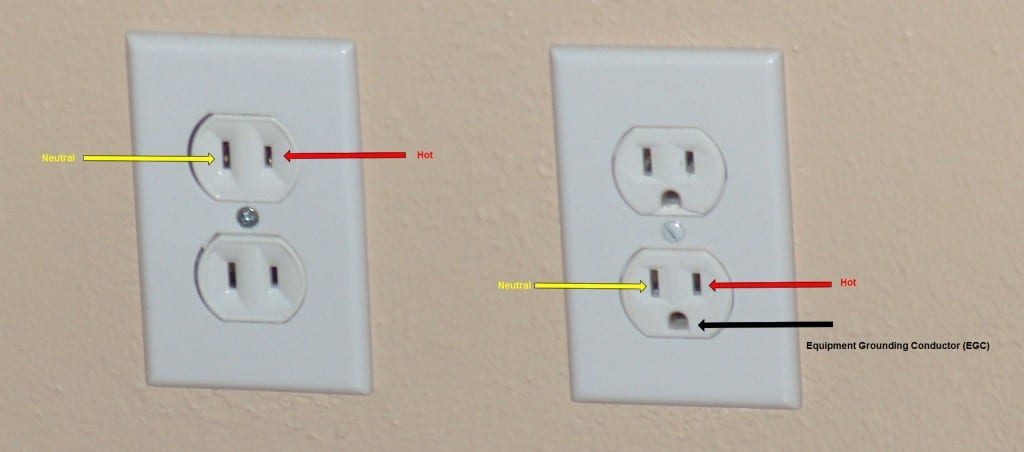If your home was built before 1960, you may still get your electricity from two-pronged outlets. However, many of today’s modern appliances, including computers, use a three-pronged plug, a safety feature that ensures the appliance cannot become electrified and shock the user.
While adapters exist to allow three-pronged plugs to receive electricity from two-pronged outlets, they are not the safest choice. Let’s dive deeper into the difference between two- and three-pronged outlets and plugs.
How Do Electrical Plugs Work?
A typical modern outlet consists of three distinct components: two vertical slits and a round hole slightly below or above their midpoint. The smaller vertical slit is known as the “hot” side, and this is where electricity flows into the plug.
The larger vertical slit is the neutral side, which acts as the pathway for electricity from the hot side to return from the plug. In an alternating current (AC) system, the direction in which the electricity enters the plug changes periodically.
What is The Third Electrical Prong For?
The third component of a three-prong outlet is the round hole or the ground. The ground prong of the plug goes into the outlet here, and it delivers any excess electricity that may have escaped the circuit, such as in the case of a loose or uninsulated wire, back to ground.
The ground prong acts as a safety feature, ensuring that any excess electricity does not electrify the metal of the appliance, creating an electrocution or fire hazard. In other words, in the event of a surge, the ground wire ensures that the excess current and voltage have a place to go that is not your body or electronics.
Read more: What Is the Difference Between a Two-Prong and a Three-Prong Plug?
Why Are Ground Prongs Used?
Three-prong plugs are the current standard, and homes built after 2008 are required to have them installed in all receptacles. In the typical modern home, just about every appliance with a metal case has a three-prong plug. Things like your computer, even if it comes in a plastic case, will have a metal-encased power supply inside.
Grounding protects users of metal-encased appliances from electric shock by connecting the casing directly to the ground prong. If you cut off the ground prong or use an adapter, the appliance will still operate, but you will have disabled an important safety feature that protects users from electric shock.
Are two-prong outlets legal and up to code?
Existing two-prong receptacles are legally allowed to remain according to the National Electrical Code. However, most appliances and devices these days are three-pronged, so it’s both safer and more convenient to have upgraded outlets.
Why should I use three-prong plugs?
The third prong grounds the electricity to protect users of metal-encased appliances from electric shock.
What will happen if I cut the third prong off my plug?
The appliance will still work, but you’ve disabled an important safety feature of the plug.
Can I use a plug adapter?
You can, but it’s not as safe as using a three-prong plug and receptacle. It’s also unsafe to plug a three-prong adapter into a surge protector that is then plugged into a two-prong outlet. There is no ground to protect you or the device from a surge. The grounding must be done at the electrical outlet itself.
While legally are not required to replace two-prong receptacles with GFCI-equipped three-prong ones, it is highly recommended to do so. It’s also smart to have a professional electrician perform a circuit test to confirm your electrical box is grounded. If it’s not, an electrician can rewire the panel with a three-wire circuit to install the necessary ground wire.
Read the article How to Ground a Two-Prong Outlet to learn more.
How Can We Help?
At Shockley Electric, we address important home safety issues such as power surges, faulty electrical wiring and potential fire hazards when we do electrical preventive maintenance in homes or commercial buildings. We are licensed, trained, and skilled in safety-proofing your home, and we are committed to the safety and well-being of our customers.
If you are experiencing electrical problems in your home or aren’t sure if your home is protected from electrical hazards, schedule an in-home estimate or appointment with us today. Fill out our form or call us now for a free estimate!

